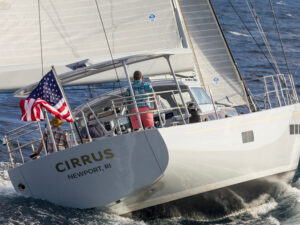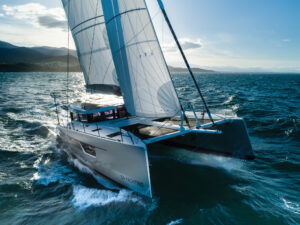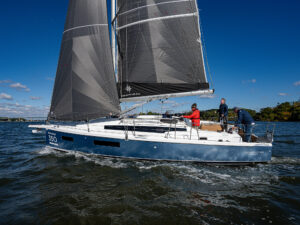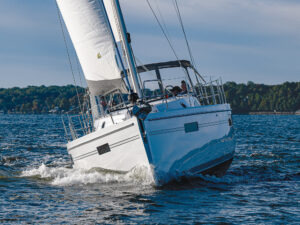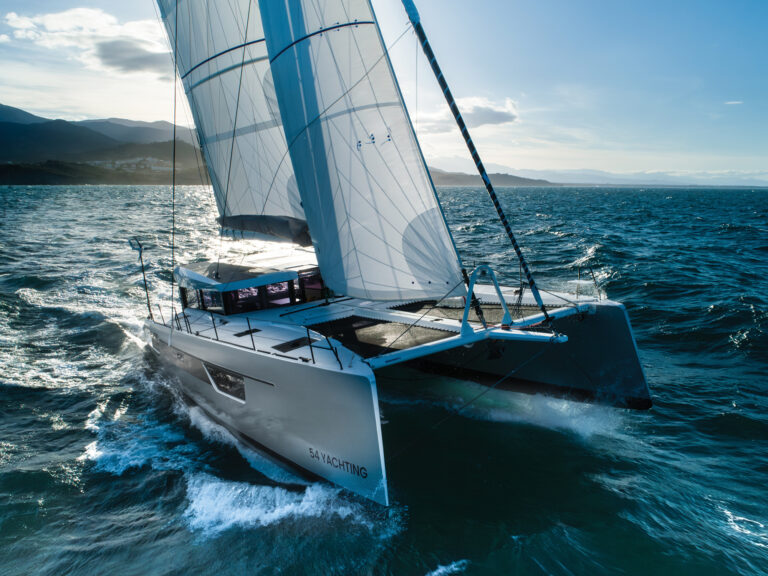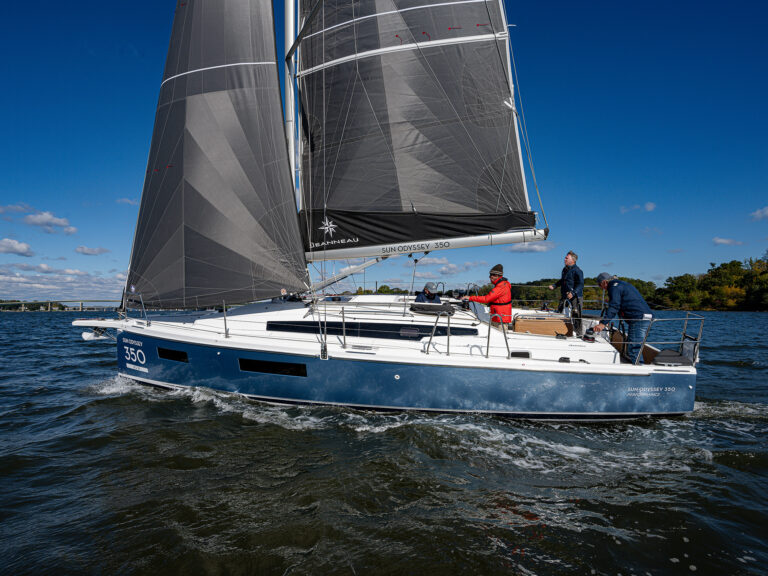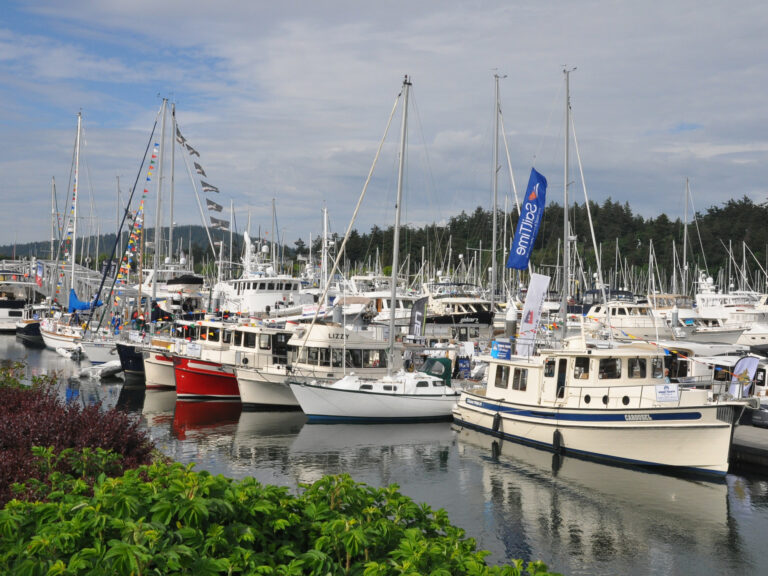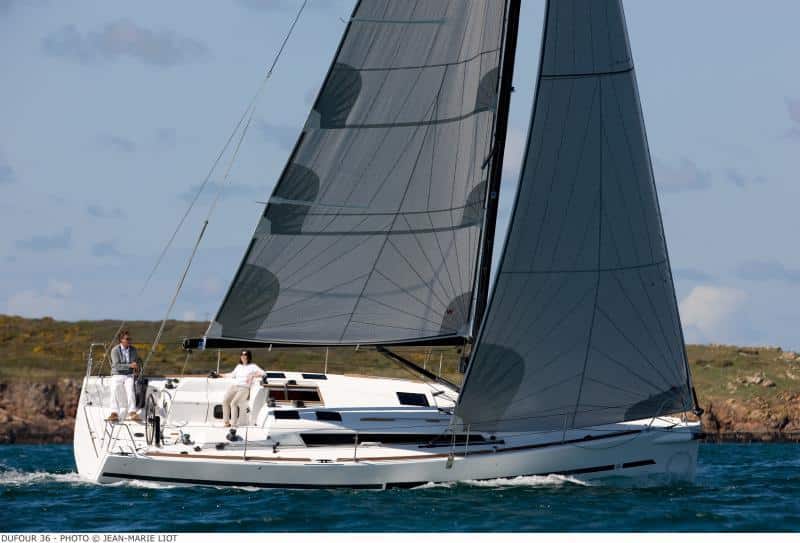
The design brief for the new Dufour 36 Performance promises “modern conservative” styling in a sailboat that delivers “exhilarating sailing performance.” After spending a light-air morning aboard the latest offering from the La Rochelle, France-based builder, I’d have to say that the team of naval architect Umberto Felci and Dufour Design hit those targets square-on. This little cruising racer—or should it be racy cruiser?—was, simply put, fun to sail.
As we tossed in a few tacks on Rhode Island’s Narragansett Bay, then hoisted up the sock to unleash a sprit-flown A-sail, the Dufour suggested strongly that a fellow and his mates could tear up the Wednesday-night beer-can series just as easily as he and the family could sail (quickly) off to a lazy weekend anchorage, where they could enjoy themselves quite comfortably on the well-organized deck and in the ample interior below.
Dufour has been building boats—between 300 and 400 annually, in recent years—since 1964, and it became a part of the Bavaria Group in 2010. The company’s model range consists of the Grand’ Large cruising line and the Performance series of racer/cruisers, of which the 36 is the latest iteration.
Reflecting current design trends, the 36 features twin wheels, a large main and easy-to-handle jib, hard chines that carry aft from just shy of amidships, and a fold-down transom/swim platform. Topside, the design’s racing intent is on display. A very functional traveler spans the cockpit forward of the helms, and cockpit lockers that double as seats can be lifted out to give trimmers and the helmsman more room to work.
The keel-stepped, 7/8ths fractional rig with double sweptback spreaders, the vang, and the boom are all from Sparcraft. On the boat we tested, the North Sails inventory included a 107-percent jib and an asymmetric spinnaker. (The standard main and 114-percent jib are by Elvström.) To control those sails, a two-ended mainsheet leads back to Lewmar winches at either helm; adjustable genoa fairleads are included to accommodate optional larger headsails. All other sail-control lines are led under the sea hood to rope clutches and a pair of cabin-top winches. A retractable sprit (available in aluminum or carbon), a removable anchor roller (with a windlass in the anchor well), and a Facnor headsail-furling system round out the hardware.
The 36 Performance’s hull is a solid, hand-laid glass-and-polyester laminate below the waterline, with a PVC foam-and-glass sandwich above. PVC-cored longitudinal stringers provide stiffness, as does a glassed-in grid that distributes mast, engine, and keel loads. The T-shaped keel is a cast-iron bulb and foil, attached with stainless-steel keel bolts.
But enough details; how did the boat sail? In the conditions we encountered—5 to 7 knots of breeze—the knotmeter matched the wind speed on a near reach, and we tacked while sailing closehauled through about 70 degrees. The ride left me wishing the sea breeze would hurry up and fill in.
Under power, the optional 40-horsepower Volvo diesel (a 30-horsepower diesel is standard) and saildrive, with a two-bladed folding prop, pushed us along at just over 7 knots at cruising rpm; we topped out at 8 knots with the throttle wide open. From cruising speed, we screeched to a halt with the motor thrown in reverse. The boat backed responsively, and moving forward at speed, it turned in just about a boat length.
As purposeful as the 36 Performance is on deck, the intent below is to provide the necessary creature comforts to help a hard-working—or fun-loving—crew unwind. The layout is fairly traditional. A roomy cabin and V-berth forward entered through double doors add to the spacious feel; full-length settees (measuring 6-feet-7-inches long) line the saloon, with a dining table and drop-leaf between. A sit-down nav desk is to starboard, across from a compact but very workable galley that features double sinks, a large refrigerator, and a two-burner propane stove and oven.
Aft of the saloon to port is another double-berth cabin. To starboard is a head and shower that can double as a wet hanging locker, and behind that is a drop-down door that provides access to a handy storage area.
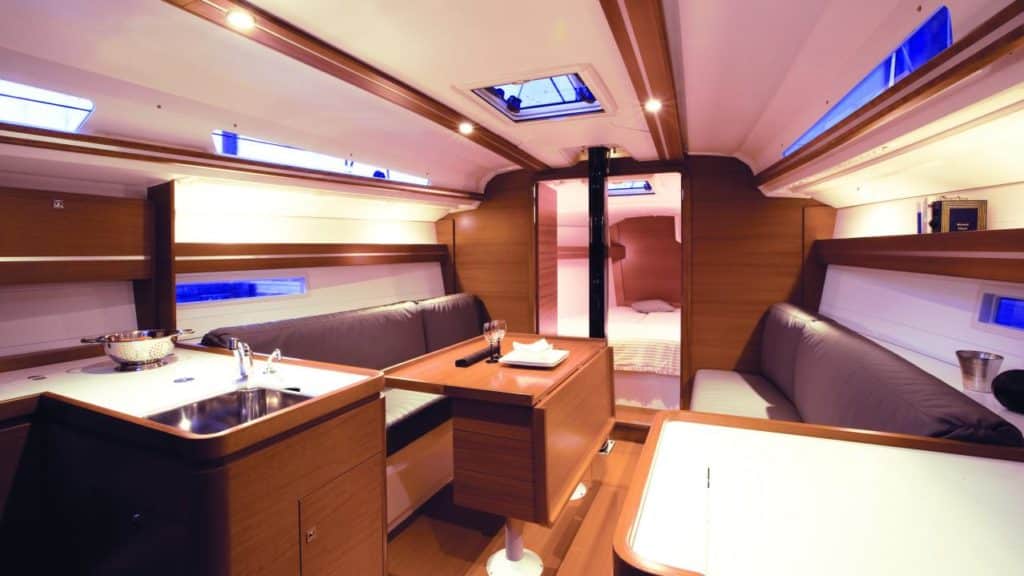
Furniture and trim are CNC-cut and made from a moabi-laminate plywood. (Resin-sealed end grain is an option.) The deck is an infused cored laminate, which allows for a finished gelcoat surface inside and out, and lets the builder control resin content and reduce weight.
I found several small touches that made the interior both pleasant and workable. For instance, the V-berth comes with a split mattress and centerline leeboard for use by racing crews. Both settees would make fine sea berths, and there’s plenty of storage behind them to keep gear out of the way. In the galley, there’s a foot pump for the water misers among us and a tip-out drawer for silverware. Access to the engine, filters, and hoses is ample. And five opening hatches ensure that plenty of fresh air will keep the cabin ventilated.
Intended to enter the market on the premium side of the production-boat scale, a base boat, delivered to the United States commissioned and with sails, lists for just under $210,000. Throw in a B&G electronics package, a navigation system, and a few toys, and a buyer can expect to sail away in the mid to high $200,000s.
The 36 Performance is constructed to European Union Category A standards, but for most sailors, the 53 gallons of water and 24 gallons of fuel will keep the boat racing and cruising nearer to the coast. And for that, this Dufour’s size, layout, and amenities should make it a serious contender for a racer’s or a performance-oriented cruiser’s consideration.
Mark Pillsbury is the editor of Cruising World.
Click here to see more photos of the Dufour 36 Performance.
To read about more Dufour yachts, click here.

